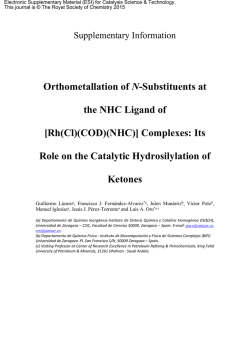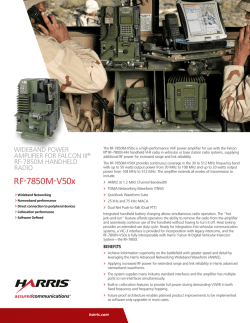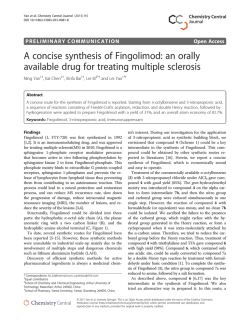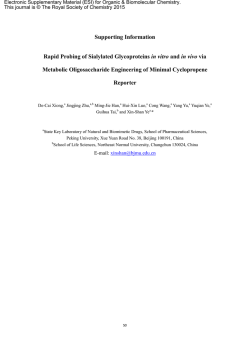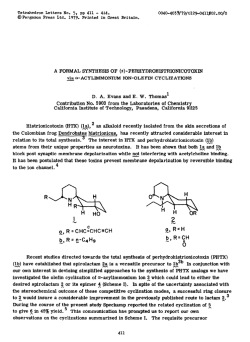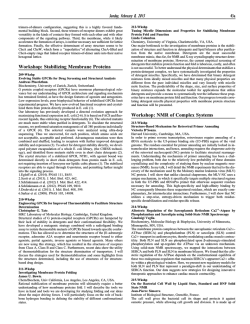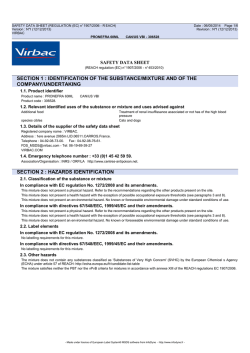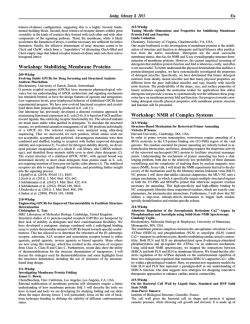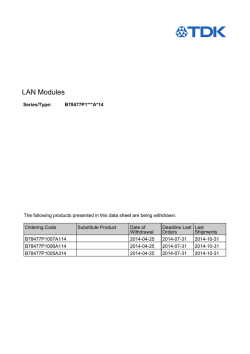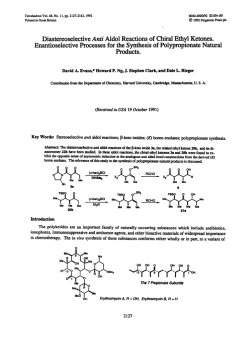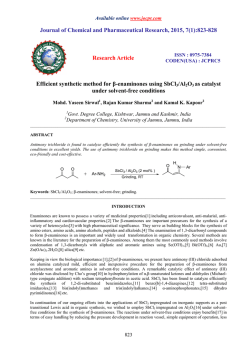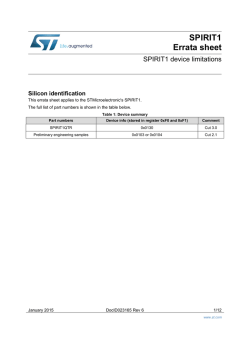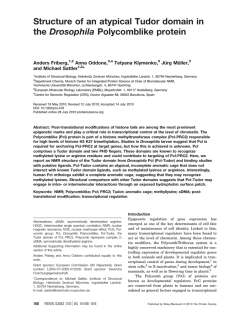
Electronic Supporting Information Photo-responsive self
Electronic Supplementary Material (ESI) for ChemComm. This journal is © The Royal Society of Chemistry 2015 Electronic Supporting Information Photo-responsive self-assemblies based on bio-inspired DNA-base containing bolaamphiphiles Ahmed S. Al-Shereiqi,a Ben J. Boydb,c and Kei Saito.a a School of Chemistry, Monash University, Clayton, Victoria 3800, Australia. Drug Delivery, Disposition and Dynamics, Monash Institute of Pharmaceutical Sciences, Monash University, Parkville Campus, 381 Royal Parade, Parkville, VIC 3052, Australia. c ARC Centre of Excellence in Convergent Bio-Nano Science and Technology, Monash Institute of Pharmaceutical Sciences, Monash University (Parkville Campus), 381 Royal Parade, Parkville, VIC 3052, Australia. b Email: [email protected] Experimental section: Materials and characterisation All reagents were purchased from Sigma-Aldrich and Tokyo Chemical Industry Co., Ltd. and used as received. Melting points were determined using a Buchi B-545 melting point apparatus with a digital thermometer. Infrared spectra were recorded on Bruker Equinox 55 in ATR mode with diamond as the background reference. The infrared data were recorded in wavenumbers (cm-1). Proton Nuclear Magnetic Resonance (1H NMR) spectra were recorded at 400 MHz on a Bruker DPX-400 spectrometer. Carbon Nuclear Magnetic Resonance (13C NMR) spectra were recorded at 100 MHz on a Bruker DPX-400 spectrometer. Electrospray ionisation mass spectra (ESI) were recorded on a Micromass platform II API QMS Electrospray mass spectrometer with cone voltage 35V. Analyses were performed in positive (ESI+) mode. Dynamic light scattering measurements were performed using Zetasizer Nano ZS instrument (Malvern, UK) by using disposable sizing cuvette (DTS0012). Analytical thin layer chromatography (TLC) was performed on Merck aluminum sheets coated with silica gel60 F254. Column chromatography was performed using Merck silica gel 60, 0.040-0.063 mm, (230-400 mesh). Irradiations were performed using a CL1000M UV-crosslinker lamp (UVP, LLC) that provided polychromatic light centred at 302 nm. Synthesis of thymine propanoate Thymine (6.3 g, 50 mmol) was dissloved in DMF (70 ml) in a 200 ml- round-bottom flask. After dissolving the thymine, triethylamine (10 ml, 70 mmol) was added to the mixture while stirring. After 1 5 minutes, methyl acrylate (7.8 ml, 50 ml) was added to the reaction mixture in a drop wise manner and the reaction was allowed to take place for 24 hours at 25 °C. After 24 hours, unreacted methyl acrylate and triethylamine were removed under reduced pressure. A white solid was obtained after the removal of DMF evaporation by using rotary evaporator. The white solid was then washed off with (50:50) ethanol and hexane solution and filtered off. The residue was dried in vacuum for 24 hours. Yield = 88 %, M.p: 128.5-131.0˚C. 1H NMR (400 MHz, CDCl3): δ 1.87 (d, J = 1.2 Hz 3H, C5-CH3), 2.77 (t, J = 6.8 Hz, 2H, CH2CO), 3.69 (s, 3H, O-CH3), 3.96 (t, J = 6.8 Hz 2H, N1-CH2), 7.19 (s, 1H, C6-H), 9.8 (s, 1H, NH). 13C NMR (100 MHz, CDCl3): δC 12.2 (C5-CH3), 32.8 (CH2CO), 44.9 (N1CH2), 52.0 (OCH3), 110.3 (C5), 141.5 (C6), 151.0 (C2), 164.5 (C4), 171.8 (COOCH3), IR: 3148s, 3089 s, 2956 m, 2884 m, 2825 s, 1694 m, 1688 m, 1481 s, 1456 m, 1380 m, 1349 m, 1253 s,1200 m, 1121 s, 1069 m, 770 s. Synthesis of 3,3'-(3,3'-(butane-1,4-diyl)bis(5-methyl-2,4-dioxo-3,4dihydropyrimidine-3,1(2H)-diyl))dipropanoate (butyl-bis-thymine) Thymine propanoate (8.0 g, 37.7 mmol) was dissolved in DMF (15 ml) in a round bottom flask and K2CO3 (7.0 g, 50 mmol) was added to the mixture under N2. The mixture was stirred for 5 minutes before the addition of diiodobutane (1.0 ml, 7.6 mmol) and then the reaction was maintained for 48 hrs at 70 °C with stirring under constant N2 flow. After 48 hours, the reaction stopped and cooled down to room temperature. The reaction mixture was decanted into 75 ml of H2O and filtration was carried out to obtain a white precipitate which was then re-crystallised from hot ethanol to yield the product. Yield = 61 %, M.p: 191.7-194.5˚C. 1H NMR (400 MHz, CDCl3): δ 1.68 (m, 4H, N3-CH2CH2), 1.90 (d, J= 1.2 Hz, 6H, C5-CH3), 2.77 (t, J = 6.4 Hz, 4H, CH2CO), 3.70 (s, 6H, OCH3), 3.96 (t, J = 6.4 Hz, 8H, N3-CH2, N1-CH2), 7.14 (d, J = 1.2 Hz 2H, C6H). 13C NMR (100 MHz, CDCl3): δ 12.9 (C5-CH3), 25.3 (N3-CH2CH2), 33.0 (CH2CO), 41.1 (N3-CH2), 45.8 (N1-CH2), 52.0 (OCH3), 109.5 (C5), 139.4 (C6), 151.3 (C2), 163.8 (C4), 171.9 (COOR). IR: 2965 m, 1727 m, 1695 m, 1656 s, 1467 s, 1388 m, 1359 m, 1243m, 1199 m, 1147m, 1106 m, 1049 m, 766 s. 2 Hydrolysis of butyl-bis-thyimine 10% NaOH (25 ml) was added to 250 ml- round bottom flask which was already charged with butylbis-thymine (1.5 g, 3.13 mmol) with stirring. Then 100 ml of water were added to the mixture and allowed to reflux for 4 hours. After 4 hours, the reaction mixture was neutralised by adding HCl. The volume was reduced till solids started to appear in the solution. The reaction mixture was placed into an ice bath for 2 hours to obtain more solid materials. After the 2 hours, the solid was collected by filtration and washed twice with cold distilled water to obtain 3,3'-(3,3'-(Butane-1,4-diyl)bis(5methyl-2,4-dioxo-3,4-dihydropyrimidine-3,1(2H)-diyl))dipropanoic acid (butyl-bis-thymine dicarboxylic acid). Yield = 88 %. M.p: 224.5-228˚C. 1H NMR (400 MHz, DMSO): δ 1.47 (br, 4H, N3-CH2CH2), 1.78 (s, 6H, C5-CH3), 2.61 (t, J = 6.4 Hz, 4H, CH2CO), 3.78 (t, J = 6.4 Hz, 4H, N3-CH2), 3.86 (t, J = 6.4 Hz, 4H, N1-CH2), 7.56 (s, 2H, C6H), 12.3 (s, 2H, COOH). 13 C NMR (100 MHz, CDCl3): δ 12.5 (C5- CH3), 24.6 (N3-CH2CH2), 32.7 (CH2CO), 39.5 (N3-CH2), 44.9 (N1-CH2), 107.3 (C5), 140.5 (C6), 150.7 (C2), 163.1 (C4), 172.3 (COOR).IR: 3115s, 2970 s, 2863s, 2344 w, 1725s, 1688s, 1661s, 1462 m, 1400 m, 1349 m, 1238 m, 1188 m, 1149 s, 1053 s, 779 s. Synthesis of bis(2-(2-(2-methoxyethoxy)ethoxy)ethyl) 3,3'-(butane-1,4diylbis(5-methyl-2,4-dioxo-3,4-dihydropyrimidine-3,1(2H)-diyl))dipropionate (bis-triethylene glycol monomethyl ether bis-thymine) Butyl-bis-thymine dicarboxylic acid (1.0 g, 2.22 mmol) was dissolved in DMF (15 ml) and then pyridine (25 ml, 0.31 mol) was added while stirring. Triethylene glycol monomethyl ether (2.0 ml, 12.5 mmol) was added to the mixture and stirred for 5 minutes. N,N'-Dicyclohexylcarbodiimide (1.0 g, 4.85 mmol) was placed into the reaction mixture and stirred for 2 hours at 0 °C. After 2 hours, the reaction was allowed to commence at ambient temperature for 48 hours. The reaction was stopped after 2 days and precipitated salt was filtered off. The filtrate was acidified with 0.1 M HCl and then washed with water (3 times) and the product was extracted with chloroform. The chloroform layer was dried with MgSO4 and removed by rotary evaporator. The product obtained was clear yellow 3 viscous liquid. Column chromatography (chloroform/methanol/acetonitrile = 5/1/3) was used to separate the mixture components in the organic layer and obtain a pure form of the product. Yield = 55 %. 1H NMR (400 MHz, CDCl3): δ 1.69 (br, 4H, N3-CH2CH2), 1.9 (s, 6H, C5-CH3), 2.81 (t, J = 6.1 Hz, 4H, CH2CO), 3.38(s, 6H, OCH3), 3.67 (m, 20H, OCH2CH2O), 3.93 (m, 8H, N3-CH2, N1CH2), 4.26 (t, J = 4.9 Hz, 4H, COOCH2) 7.15 (s, 2H, C6H). 13C NMR (100 MHz, CDCl3): 12.2 (C5CH3), 25.2 (N3-CH2CH2), 32.9 (CH2CO), 41.1 (N3-CH2), 45.7 (N1-CH2), 59.0 (OCH3), 64.1(COOCH2), 68.8 (COOCH2-CH2-O), 70.5(O-CH2CH2-O-CH2), 71.9 (CH2-OCH3), 109.4 (C5), 139.5(C6), 151.3 (C2), 163.8 (C4), 171.4 (COOR). MS (ESI)+: Calcd for C34H54N4O14: 765.350 (M+Na)+; Found: 765.353 (M+Na)+ . IR: 3407s, 2920 s, 2322 w, 1730s, 1694s, 1670s, 1465 s, 1359 m, 1323 m, 1249s, 1190 m, 1092 s, 768 s. Synthesis of di(2,5,8,11,14,17-hexaoxanonadecan-19-yl) 3,3'-(butane-1,4diylbis(5-methyl-2,4-dioxo-3,4-dihydropyrimidine-3,1(2H)-diyl))dipropionate (bis-hexaethylene glycol monomethyl ether bis-thymine) O 6 O O N O O N N O O N O O 6 O Butyl-bis-thymine dipropanoic acid (0.819 g, 1.8 mmol) was dissolved in DMF (15 ml) in a roundbottom flask. While stirring, 4-dimethylaminopyridine (0.123 g, 1.0 mmol) was added to the mixture followed by the addition of hexaethyelene glycol monomethyl ether (HEG) (1 ml, 3.6 mmol). After that, the flask was placed in ice bath and dicyclohexylcarbodiimide (DCC) (0.79 g, 3.8 mmol) was then added to the mixture while stirring. After 2 hours stirring in the ice bath, the reaction was allowed to commence at room temperature for 2 days. After 48 hours, precipitated urea (DHU salt) was filtered off and the filtrate was evaporated by using rotary evaporator to remove DMF. The residue was taken up in CHCl3 (or CH2Cl2) filtered again to remove further precipitated urea. The CHCl3 solution was washed twice with H2O and then the chloroform layer was dried with MgSO4 and evaporated to give white viscous material residue dried in vacuo. Column chromatography (chloroform/methanol/acetonitrile = 5/1/3) was used to separate the mixture components in the organic layer and obtain a pure form of the product. Yield = 66 %. 1H NMR (400 MHz, CDCl3): δ 1.71 (br, 4H, N3-CH2CH2), 1.92 (s, 6H, C5-CH3), 2.81 (t, J = 5.9 Hz, 4H, CH2CO), 3.39 (s, 6H, CH3OC), 3.66 (m, 44H, OCH2CH2O), 3.98 (t, J = 6.1 Hz, 4H, N3-CH2), 4.04 (t, J = 5.9 Hz, 4H, N1-CH2) 4.27 (t, J = 4.7 Hz, 4H, COOCH2) 7.18 (s, 2H, C6H). 13 C NMR (100 MHz, CDCl3): 12.9 (C5-CH3), 25.2 (N3-CH2CH2), 33.0 (CH2CO), 41.1 (N3-CH2), 4 46.9 (N1-CH2), 59.0 (OCH3), 64.1 (COOCH2), 68.9 (COOCH2-CH2-O), 70.6 (O-CH2CH2-O-CH2), 71.9 (CH2-OCH3), 109.4 (C5), 139.8 (C6), 151.3 (C2), 163.7 (C4), 171.4 (COOR). MS (ESI)+: Calcd for C46H78N4O20: m/z 1029.5 (M+Na)+; Found: m/z 1029.5 (M+Na)+. IR: 3309s, 2932 s, 2863s, 2324 w, 1733s, 1694s,1665s, 1535 s, 1475 m, 1355 m, 1190 m, 1100 s, 769s Characterisation of bolaamphiphile 1after UV-irradiation The compound was characterised after UV-irradiation by NMR and IR: 1 H NMR (400 MHz, CDCl3): δ 0.87 (br, 3H, cyclobutane-CH3), δ 1.79 (br, 4H, N3-CH2CH2), 1.9 (s, 3H, C5-CH3), 2.77 (br, 4H, CH2CO), 3.10 (br, 1H, cyclobutane–CH), 3.37 (s, 6H, OCH3), 3.65 (m, 20H, OCH2CH2O), 3.93 (m, 8H, N3-CH2, N1-CH2), 4.23 (m, 4H, COOCH2) 7.2 (s, 1H, C6H) IR: 3330w, 2931 s, 2865w, 2326 w, 1695 w,1665s, 1542 w, 1466 m, 1352 m, 1190 w, 1081 w, 755s Characterisation of bolaamphiphile 2 after UV-irradiation The compound was characterised after UV-irradiation by NMR and IR: 1 H NMR (400 MHz, DMSO): δ 0.87 (br, 6H, cyclobutane-CH3), δ 1.74 (br, 4H, N3-CH2CH2), 2.69 (m, 4H, CH2CO), 3.27 (s, 6H, CH3OC), 3.56 (m, 44H, OCH2CH2O), 4.04 (m, 8H, N3-CH2, N1-CH2) 4.14 (br, 4H, COOCH2). 13C NMR (100 MHz, DMSO): δ 13.0 (C5-CH3), 19.0 (C5), 25.5 (N3CH2CH2), 33.5 (CH2CO), 45.3 (N3-CH2), 48.5 (N1-CH2), 58.5 (C6), 60.6 (OCH3), 64.0 (COOCH2), 68.7 (COOCH2-CH2-O), 71.6 (O-CH2CH2-O-CH2), 79.5 (CH2-OCH3), 161.5 (C2), 171.1 (C4), 171.6 (COOR). IR: 3327w, 2930 s, 2865w, 2336 w, 1695 w, 1661s, 1540 w, 1450 m, 1352 m, 1194 w, 1081 w, 756s Critical micelle concentration measurement Fluorescence spectroscopy was used to determine the critical aggregation concentration by using pyrene as a probe. Pyrene solution (6.0 x 10-2) was made up by using acetone as the solvent which was then diluted by water. The acetone in the solution mixture was evaporated to form an acetone-free pyrene solution with a final concentration of 12.0 x 10-7 M. The pyrene solution (2 ml) was added to each monomer solution (2 ml) whose concentrations ranging from 1.0 x10-6 M to 1.0 x 10-2 M in bolaamphiphile 1 and 1.0 x10-6 M to 1.0 x 10-2 M in bolaamphiphile 2 . The final conecetration of pyrene in each sample was 6.0 x 10-7 M and the final concentrations of the bolaamphiphiles 1 & 2 solutions were between 2.3 ×10-9 to 2.3×10-3 M and 2.6 ×10-11 to 2.6 ×10-3 M, respectively. Preparation of bolaamphiphiles for TEM characterisation • Cryo-TEM: 45 mg of both monomers 1&2 were dissolved in water in 6 ml and 10 ml, respectively. The samples were centrifuged for 30 min at 4000 rpm. Half of the supernatant was irradiated by UV-light at 302 nm for 3 days by using ice bath to control the temperature. Both the 5 irradiated and non-irradiated samples were examined by TEM. The final concentrations of both bolaamphiphiles 1& 2 were 1.0 ×10-2 M and 4.5 ×10-3 M. • TEM with staining: The same method was followed but lower concentration was obtained (bolaamphiphiles 1 was 4.5 ×10-3 M and bolaamphiphiles 2 was 5.0 ×10-3M). The stain used was phosphate tungstic acid. Fig.S1 Cryo-TEM image of bolaamphiphile 2 after irradiation. Dynamic light scattering (DLS) One 1-ml sample of both bolaamphiphiles dispersions (before and after UV-irradiation) were placed in DLS disposable sizing cuvettes (DTS0012), and measurements of the size distribution (mean particle size (z-ave) and polydispersity index (PDI)) of the self-assembled structures before and after UV-irradiation were taken by using Zetasizer Nano ZS instrument. Table 1: Mean particle size (z-average) of the self-assembled structures before and after UVirradiation: Bolaamphiphile Average size (nm) before UV- Average size (nm) after UV- irradiation irradiation 1 >6000 100 2 >6000 215 6 Fig.S2 DLS measurement of bolaamphiphile 1 before irradiation. Fig.S3 DLS measurement of bolaamphiphile 1 after irradiation. Fig.S4 DLS measurement of bolaamphiphile 2 before irradiation. 7 Fig.S5 DLS measurement of bolaamphiphile 2 after irradiation. Viscosity measurements Viscosity of the solution before and after the irradiation was measured using rheometer (Anton Parr Physica MCR501). 0.2 B1-before UV η (Pa.s) B1-After UV 0.1 0.0 0 100 Time (s) 200 300 Fig.S6 Viscosity measurement of bolaamphiphile 1. B2-Before UV η (Pa.s) 0.10 B2-After UV 0.05 0.00 0 100 Time (s) 200 Fig.S7 Viscosity measurement of bolaamphiphile 2. 8 300
© Copyright 2025
